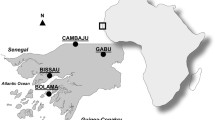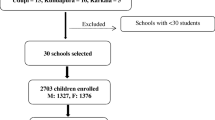Abstract
A longitudinal study was carried out in an area of endemic goiter of north-eastern Sicily. Three different surveys (in 1977, 1983 and 1994) evaluated the epidemiological prevalence of goiter in schoolchildren of the endemic area (towns of Bronte, Troina and Maniaci) in comparison to an iodine sufficient control area (Catania). Biochemical studies were also performed on urinary iodine and thiocyanate (SCN) excretion and 131I thyroid uptake. In the town of Troina an experimental program of active iodine prophylaxis was carried out from 1979 to 1987 by iodinating the municipal water supply. The aim of this study was to evaluate the effect of an active iodine prophylaxis program in comparision to the “silent iodoprophylaxis” due to improved economic conditions and widespread introduction of industrially produced food. In the 1977–94 period a significant decrease of goiter prevalence in schoolchildren was observed in all areas where no active iodoprophylaxis had been introduced. An abnormal prevalence of goiter, however, was still present in Bronte (12.1%) and Maniaci (25.9%) schoolchildren in respect to Catania (0.7%). In Troina, goiter prevalence decreased from 52.2 to 6.1% after only five years of active iodine prophylaxis (1983). It increased to 8.4% seven years after the program was discontinuated (1994). In all areas studied average urinary iodine excretion increased by 70–100 μg/day except in the more rural area at Maniaci. During the same period urinary SCN values decreased by 30–40% and were lower in Troina (non volcanic soil) than in other towns studied. The balance beetween iodine and SCN intake appears a relevant factor in the etiology of endemic goiter in these areas and the iodine/SCN ratio inversely correlated with goiter prevalence. The persistence of endemic goiter in spite of the important changes in life style and socio-economic conditions if compared to the dramatic amelioration obtained by an active iodine prophylaxis program, confirms the inadequacy of the silent iodine prophylaxis, and further supports the need of an immediate introduction of active iodine prophylaxis in the areas of endemic goiter in Sicily.
Similar content being viewed by others
References
Delange F., Vigneri R., Trimarchi F., Filetti S., Pezzino V., Squatrito S. Etiological factors of endemic goiter in North-Eastern Sicily. J. Endocrinol. Invest. 2: 137, 1978.
Sava L., Delange F., Belfiore A., Purrello F., Vigneri R. Transient impairment of thyroid function in newborn from an area of endemic goiter. J. Clin. Endocrinol. Metab. 59: 90, 1984.
Belfiore A., Sava L., Runello F., Tomaselli L., Vigneri R. Solitary autonomously functioning thyroid nodules and iodine deficiency. J. Clin. Endocrinol. Metab. 56: 283, 1983.
Belfiore A., La Rosa G.L., Padova G., Sava L., Ippolito O., Vigneri R. The frequency of cold thyroid nodules and thyroid malignancies in patients from an iodine-deficient area. Cancer 60: 3096, 1987.
Squatrito S., Delange F., Trimarchi F., Lisi E., Vigneri R. Endemic cretinism in Sicily. J. Endocrinol. Invest. 4: 295, 1981.
Bourdoux P., Delange F., Gerard M. Evidence that Cassava ingestion increases thiocyanate formation: a possible etiologic factor in endemic goiter. J. Clin. Endocrinol. Metab. 4: 613, 1978.
Thilly C.H, Vanderpas J.B., Bebe N., Ntambue K., Contempre B., Swennen B. Iodine deficiency, other trace elements, and goitrogenic factors in the etiopathogeny of iodine deficiency disorders (IDD). Biol. Trace Elem. Res. 32: 229, 1992.
Thilly C.H., Contempre B., Vanderpas J.B. Thiocyanate excess and Selenium deficiency: factors in the etiology of goiter and of endemic cretinism in Northern Zaire. Bull. Acad. R. Med. Belg. 145: 440, 1991.
Delange F., Ermans A.M. Endemic goiter and cretinism. Naturally occurring goitrogens. Pharmacol. Ther. 1: 57, 1976.
Squatrito S., Vigneri R., Runello F., Ermans A.M., Polley R.D., Ingbar S.H. Prevention and treatment of endemic iodine-deficiency goiter by iodination of a municipal water supply. J. Clin. Endocrinol. Metab. 63: 368, 1986.
Perez C., Scrimshaw N.S., Munoz J.A. Technique of endemic goitre survey. In: World Health Organization, (Eds.), Endemic goitre. WHO, Monograph Series, Geneva, 1960, vol. 44, p. 369.
Querido A., Delange F., Dunn T., Fierro-Benitez R., Ibbertson H.K., Koutras D.A. Definitions of endemic goiter and cretinism, classification of goiter size and severity of endemias and survey techniques. In: Dunn J.T., Medeiros-Neto G.A. (Eds.), Endemic goiter and cretinism. Continuing threats to world health. Pan American Health Organization scientific publication 292: 267, 1974.
Riley M., Golhman N. A fully automated method for the determination of serum protein bound iodine. Technicon Symposium, New York, 1964, p. 1.
Aldridge W.N. The estimation of microquantities of cyanide and thiocyanate. Analyst 70: 474, 1945.
Michajlovski N, Langer P. Studien uber beziehungen zwischen rhodanbildung und kropflieldender eigenschaft von nahrungsmittein an praformierten rhodanid. Z. Psysiol. Chem. 312: 26, 1958.
Christensen S.B., Ericson U.B., Janzon L., Tibblin S., Melander A. Influence of cigarette smoking on goitre formation, thyroglobulin and thyroid hormone levels in women. J. Clin. Endocrinol. Metab. 58: 615, 1984.
Brunn J., Block U., Ruf G., Bos J., Kunze W.P., Scriba P.C. Volumetrie der Schilddrusenlappen mittels Real-time-Sonographie. Dtsch. Med. Wochenschr. 106: 1338, 1981.
Gutekunst R., Smolarek H., Wachter W., Scriba P.C. Strumaepidemiologie. IV. Schilddrusenvolumina bei deutschen und schwed-ischen Schulkinder. Dtsch. Med. Wochenschr. 110: 50, 1985.
Vitti P., Martino E., Aghini-Lombardi F., Rago T., Antonangeli L., Maccherini D., Nanni P., Loviselli A., Balestrieri A., Araneo G., Pinchera A. Thyroid volume measurement by ultrasound in children as a tool for the assessment of mild iodine deficiency. J. Clin. Endocrinol. Metab. 79: 600, 1994.
Berghout A., Wiersinga W.M., Smits N.J., Touber J.L. Determination of thyroid volume as measured by ultrasonography in healthy adults in a non-iodine deficient area. Clin. Endocrinol. (Oxf.) 26: 273, 1987.
Gutekunst R., Smolarek H., Hasenpusch U. Goitre epidemiology: thyroid volume, iodine excretion, thyroglobulin and thyrotropin in Germany and Sweden. Acta Endocrinol. (Copenh.) 112: 273 1986.
Gutekunst R. The value and application of ultrasonography in goiter survey. IDD Newslett. 6: 3, 1990.
Delange F., Vigneri R., Trimarchi F., Filetti S., Pezzino V., Squatrito S. The iodine/thiocyanate ratio. In: Ermans A.M., Mbulanoko N.M., Delange F., Alhuwalia R., (Eds.), Role of Cassava in the etiology of endemic goiter and cretinism. International Development Research Centre Publ, Ottawa, 1980, vol. 13, p. 143.
Hennart P., Bourdoux P., Lagasse R., Thilly C., Putzeys G., Courtois P. Epidemiology of goitre and malnutrition and dietary supplies of iodine, thiocyanate, and proteins in Bas Zaire, Kivu, and Ubangi. In: Delange F., Iteke F.B., Ermans A.M., (Eds.), Nutritional factors involved in the goitrogenic action of Cassava. International Development Research Centre Publ., Ottawa, 1982, vol. 2, p. 25.
Michajlovskij N., Sedlak J., Kostekova O. Content of naturally occurring goitrogens in boiled plants of Brassica family. Endocrinol. Exp. 4: 51, 1969.
Author information
Authors and Affiliations
Rights and permissions
About this article
Cite this article
Regalbuto, C., Squatrito, S., La Rosa, G.L. et al. Longitudinal study on goiter prevalence and goitrogen factors in northeastern Sicily. J Endocrinol Invest 19, 638–645 (1996). https://doi.org/10.1007/BF03349031
Accepted:
Published:
Issue Date:
DOI: https://doi.org/10.1007/BF03349031




